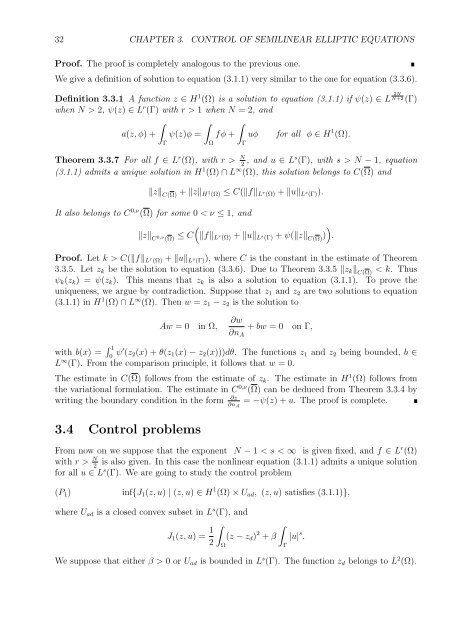Optimal Control of Partial Differential Equations
Optimal Control of Partial Differential Equations
Optimal Control of Partial Differential Equations
Create successful ePaper yourself
Turn your PDF publications into a flip-book with our unique Google optimized e-Paper software.
32 CHAPTER 3. CONTROL OF SEMILINEAR ELLIPTIC EQUATIONS<br />
Pro<strong>of</strong>. The pro<strong>of</strong> is completely analogous to the previous one.<br />
We give a definition <strong>of</strong> solution to equation (3.1.1) very similar to the one for equation (3.3.6).<br />
Definition 3.3.1 A function z ∈ H1 (Ω) is a solution to equation (3.1.1) if ψ(z) ∈ L 2N<br />
N+2 (Γ)<br />
when N > 2, ψ(z) ∈ Lr (Γ) with r > 1 when N = 2, and<br />
<br />
a(z, φ) + ψ(z)φ = fφ + uφ for all φ ∈ H 1 (Ω).<br />
Γ<br />
Ω<br />
Theorem 3.3.7 For all f ∈ L r (Ω), with r > N<br />
2 , and u ∈ Ls (Γ), with s > N − 1, equation<br />
(3.1.1) admits a unique solution in H 1 (Ω) ∩ L ∞ (Ω), this solution belongs to C(Ω) and<br />
z C(Ω) + z H 1 (Ω) ≤ C(fL r (Ω) + uL s (Γ)).<br />
It also belongs to C 0,ν (Ω) for some 0 < ν ≤ 1, and<br />
z C 0,ν (Ω) ≤ C<br />
Γ<br />
<br />
fL r (Ω) + uL s (Γ) + ψ(z C(Ω) )<br />
Pro<strong>of</strong>. Let k > C(fL r (Ω) + uL s (Γ)), where C is the constant in the estimate <strong>of</strong> Theorem<br />
3.3.5. Let zk be the solution to equation (3.3.6). Due to Theorem 3.3.5 zk C(Ω) < k. Thus<br />
ψk(zk) = ψ(zk). This means that zk is also a solution to equation (3.1.1). To prove the<br />
uniqueness, we argue by contradiction. Suppose that z1 and z2 are two solutions to equation<br />
(3.1.1) in H 1 (Ω) ∩ L ∞ (Ω). Then w = z1 − z2 is the solution to<br />
Aw = 0 in Ω,<br />
∂w<br />
+ bw = 0 on Γ,<br />
∂nA<br />
with b(x) = 1<br />
0 ψ′ (z2(x) + θ(z1(x) − z2(x)))dθ. The functions z1 and z2 being bounded, b ∈<br />
L ∞ (Γ). From the comparison principle, it follows that w = 0.<br />
The estimate in C(Ω) follows from the estimate <strong>of</strong> zk. The estimate in H1 (Ω) follows from<br />
the variational formulation. The estimate in C0,ν (Ω) can be deduced from Theorem 3.3.4 by<br />
= −ψ(z) + u. The pro<strong>of</strong> is complete.<br />
writing the boundary condition in the form ∂z<br />
∂nA<br />
3.4 <strong>Control</strong> problems<br />
From now on we suppose that the exponent N − 1 < s < ∞ is given fixed, and f ∈ Lr (Ω)<br />
with r > N is also given. In this case the nonlinear equation (3.1.1) admits a unique solution<br />
2<br />
for all u ∈ Ls (Γ). We are going to study the control problem<br />
(P1) inf{J1(z, u) | (z, u) ∈ H 1 (Ω) × Uad, (z, u) satisfies (3.1.1)},<br />
where Uad is a closed convex subset in Ls (Γ), and<br />
J1(z, u) = 1<br />
<br />
(z − zd)<br />
2<br />
2 <br />
+ β<br />
Ω<br />
We suppose that either β > 0 or Uad is bounded in L s (Γ). The function zd belongs to L 2 (Ω).<br />
Γ<br />
|u| s .<br />
<br />
.

















